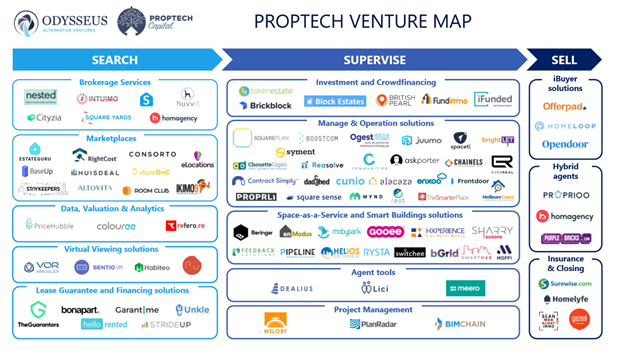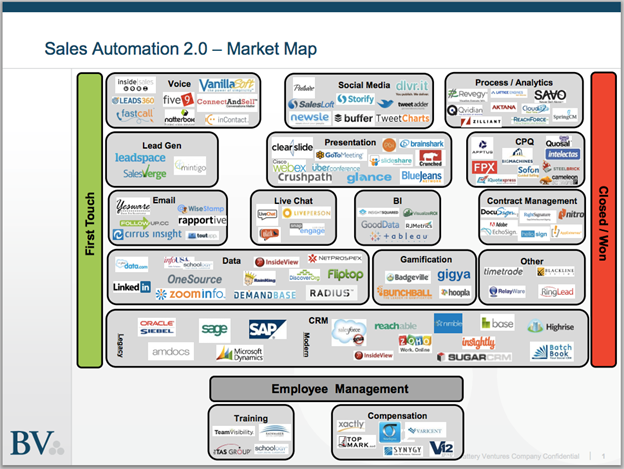Sourcescrub and Grata are joining forces to deliver the market’s most complete market intelligence platform
Learn more

There are two words that strike dread deep in the hearts of even the bravest and most experienced dealmakers: market mapping.
Market mapping refers to researching all of the companies in a given space, and then plotting them on a grid to better understand where they sit in relation to one another and within the larger ecosystem. The process is extremely valuable because it enables private equity and investment banking firms to refine their investment thesis, develop expertise in specific sectors, and identify ideal targets.
If you're a dealmaker, market mapping is a core part of your job and something you do on a regular basis. But that doesn't make it any easier. Imagine that your investment thesis is focused on "marketing technology." You would need to start by identifying all 8,000+ current marketing technology companies!
From there, you'd divide these marketing technology companies into specific sub-industries like email marketing, content creation, account-based marketing, mobile advertising, etc. The more fragmented or niche the market you're mapping, the more likely it is to overlook or misclassify what could actually be a top target.
The final step would be to further segment these companies based on size and health to determine market leaders and strategic acquirers, potential platform investments, and smaller add-ons.

Rather than focusing on industries, some firms take a situation-based approach to market mapping where they identify previously high-growth companies that have slowed down, for instance. Another method is to map markets based on particular use cases or workflows to show how one group of solutions or services depends on or leads to the next.

Either way, the process is extremely meticulous and often takes dealmakers weeks to complete - especially when it involves private and bootstrapped companies.
There are about 30 million pre-transacted companies in the market — that's more than investor-backed and public companies combined. And while it's fairly easy to find information about public companies via Google and traditional data service providers, piecing together accurate, complete data for private and pre-transacted businesses is extremely manual and time-consuming.

"I think of markets as giant pyramids," says Charles Shannon, a seasoned Corporate Development professional. "The bigger public companies are at the top. Then you have mid-size transacted companies in the middle. But the majority of the pyramid consists of smaller bootstrapped companies, which are the acquisition targets most difficult to find and can provide the most value."
Many firms' market maps fail to capture relevant companies and top investment targets because they simply don't know these businesses exist. The private companies that they do know about are often classified incorrectly due to a lack of accurate or clear information. In both instances, valuable insights and potential proprietary opportunities are left on the table.
What's more, market maps must be continually updated as new players enter the space, existing businesses grow or pivot, and companies are bought and sold. Finding the latest logos to add to their market maps is an on-going challenge for dealmakers as they race to discover these up-and-coming companies before the competition.
Traditionally, dealmakers have had to rely mostly on analyst reports, Google search,spreadsheets, and PowerPoint to research, classify, and organize market maps. And while these tools still have their place in the segmenting process, there are a number of new technologies and solutions that significantly ease the pain of mapping markets for dealmakers.
For example, leading deal sourcing platforms provide sources-first data that is the result of connecting information across hundreds or even thousands of individual sources. The result is a web of insight that not only delivers verified, high quality private company details, but also offers the context necessary to better understand entire categories and derive deeper, less obvious data signals about these companies' growth intent. Some of these data signals include:
In addition to saving teams significant time once spent manually compiling information for market mapping purposes, these tools also bubble up lesser-known private or bootstrapped companies that firms may otherwise overlook. Some further accelerate market mapping by harnessing data science to aid firms in the industry and sub-industry classification process.
Traditional industry classifiers such as NAICS or SIC codes are antiquated, often inaccurate, and unnecessarily rigid. New processes use extensive datasets and sophisticated classification algorithms to apply industry designations that are more accurate, more adaptable, and allow companies to belong to multiple industries based on their complete range of markets and activities.
Finally, the most cutting-edge deal sourcing platforms are beginning to leverage generative AI to reduce the time needed to map even highly fragmented or niche industries to mere minutes. As Jessica Ginsberg, Managing Director at LFM Capital says, "While it's still early days for generative AI specifically, this is another step forward. The way that this tool can help us build a landscape of "like" companies — those with similar characteristics to ones we've identified as having outstanding potential, or that are already in our portfolio — with more accuracy and speed is remarkable."
Another tool dealmakers can use to accelerate the market mapping process is Miro. Miro is a visual collaboration platform that functions as a dynamic, digital white board. Rather than struggling to structure markets and plot company logos on PowerPoint slides, firms can use Miro to quickly and easily build and adjust their in-progress maps. Here's a market mapping template you can adapt to get started with Miro.
Last but not least, leading firms are increasingly relying on CRMs to capture and organize the information they collect about the logos on their market maps. Platforms like Salesforce, Dynamo Software,and Altvia track important contact and company data, as well as record every interaction and relationship milestone. Unlike static, siloed spreadsheets, CRMs effectively centralize market data and can even automatically refresh company details through integrations with leading data service providers and sales automation tools.
Shortly after joining the leading SaaS-based technology provider for global mergers and acquisitions (M&A) professionals, the company's new Senior Vice President of Corporate Development was asked to create, build, and launch an M&A strategy in just 6 weeks. The first step? Map the market.
He immediately began using Sourcescrub to discover, understand, and map private and founder-owned companies across the global M&A landscape- a process he continues to replicate to identify new and emerging companies each month as he explores additional sectors. After searching various lists by keywords like industry and ownership, he then filters them by data signals that indicate positive growth, like new hires and job postings.
"Sourcescrub gives me names of relevant companies that I otherwise wouldn't even know exist "let alone that they're growing," he reveals. "The tool also feeds into itself. Once I have an initial list of companies, I can then search for others with similar profiles, which leads to another list, and so on and so forth."
Using Sourcescrub, this Corp Dev executive was able to evaluate over 6,000 businesses, narrow this list down to 600 companies, and develop a comprehensive corporate development strategy just in time for the team's board meeting. Creating his initial market map took just 4 weeks- a project that would have taken 12 weeks without Sourcescrub, resulting in 3x time savings!
Market mapping has long been a source of anxiety and frustration for dealmakers. But thanks to the latest data and technology advancements, firms no longer have to spend weeks scraping the bottom of Google for basic company information- even when it comes to private businesses.
Sources-first, AI-powered deal sourcing platforms now serve up key company data signals, highlight competitors that belong to similar market segments, and use advanced algorithms to classify businesses with an unparalleled level of accuracy. Tools like Miro make it easy to visually build and adjust market maps over time, while CRMs like Affinity and Sugar help firms track and internally distribute information for every company on a given map.
See for yourself how Sourcescrub can help your firm understand specific sectors, develop proprietary market views, and identify opportunities faster than your competitors.
Just let us know if you'd like to schedule sometime for us to show you how data-driven dealmakers are taking advantage of these new capabilities.